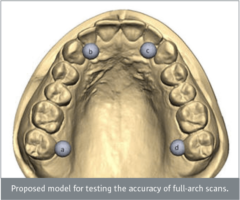CAD/CAM and 3-D printing have arrived with full force in dentistry. NIOM is leading the work to secure standards for scanning accuracy.
 NIOM leads the ISO working group responsible for the development of a new standard: Methods for Assessing the Accuracy of Hand-Held Scanning Devices for Digital Impressions.
NIOM leads the ISO working group responsible for the development of a new standard: Methods for Assessing the Accuracy of Hand-Held Scanning Devices for Digital Impressions.
With the increased use of 3D printing in dentistry, focus falls on the accuracy of the digital impression from which all prosthetic design begins. A digital impression is a virtual model of a patient’s dentition, obtained either indirectly by scanning a traditional gypsum model or directly with an intra-oral scanner.
The confines of the oral cavity limit data acquisition and impose uncertainties on digital registration. The digital impression may become unacceptably inaccurate when scanning for a large prosthesis.
Intra-oral scanners work with a variety of technologies, but with a number of common features:
- Acquisition of a sequence of data frames with the surface topography seen by the scanner
- Registration of the areas of overlap between the frames to deduce the motion of the scanner
- Rendering of the topography into formats suited for appliance design and manufacturing
At present, the ISO working group led by NIOM has prepared a draft for the development of the standard and welcomes comments and feedback via the ISO balloting system. We urge interested dentists and manufacturers to contact their national standardization body for draft details and to submit comments. The deadline for comments is April 13, 2017.

